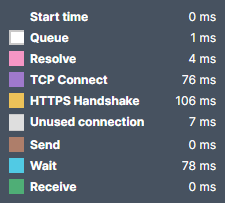For some kinds of monitors you can get a waterfall chart as a result of the monitor check. The waterfall contains a waterfall chart which is a graphical presentation of how long it took the page elements to load.
When hovering over the chart you can zoom in on the timings per element.

Steps of the loading process
The timings are split out by a number of steps that are needed to load the element. A legend with the colors of the steps is located at the top of the waterfall chart:

All timings are shown in milliseconds. The different steps in the loading process are described below.
Start
The Start value is the only value in this collection which is not a duration, but a point in time. More precisely, this is the point in time when the loading of the related page element started within the complete timeline of the page.
Queue
The Queue time is the duration a request was queued for.
There are different reasons for queueing:
- Request with higher priority exist. For example, images often have lower priority than scripts or stylesheets.
- The request is waiting for a TCP socket to be released.
- There are already 6 TCP connections open for the same origin. This reason applies only to HTTP/1.0 and HTTP/1.1.
- The browser is allocating space in the disk cache.
Resolve
This is the time that the browser needed to perform the DNS lookup for the page element. The DNS lookup is used to translate a domain name or URL to the corresponding IP address.
TCP connect
TCP connect is the time that it takes to establish the actual TCP connection from the client to the IP address of the web server.
HTTPS handshake
A handshake consists of a number of sub-steps that are necessary to initiate a secure communication between client and server. This step is also known as a TLS handshake.
Send
Once the connection is established and secure communication was negotiated, the client will send a request to the web server.
Wait
This is the time it takes between the sending of a request and the response from the web server.
Receive
This step captures the time needed to receive the response from the web server.
Timeout
This timing only applies if the request failed. In that case it shows the period during which the client did not receive any response. There will be a start time and timeout period only in this case, no other timings.